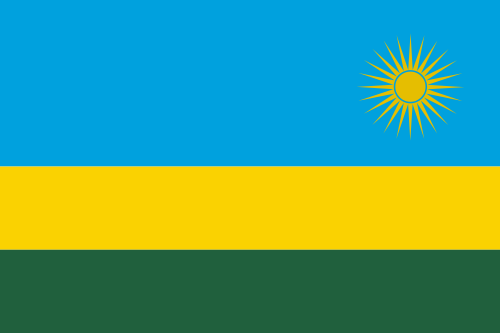
Country Flags by Continent
|
|
The flag of Rwanda was adopted on October 25, 2001.
The flag has four colours: blue, green, and two forms of yellow (standard yellow for the middle band and what the Pantone system calls "sun yellow" for the sun).
The blue band represents happiness and peace, the yellow band symbolizes economic development, and the green band symbolizes the hope of prosperity. The sun represents enlightenment.
The flag was designed by Alphonse Kirimobenecyo.
The Republic of Rwanda is a unitary republic of central and eastern Africa with a population of approximately 11.1 million (2010).
Rwanda is located a few degrees south of the Equator, and borders Uganda to the north, Tanzania to the east, Burundi to the south, and the Democratic Republic of the Congo to the west. The capital is Kigali, which is near the centre of the country. Rwanda is landlocked but has many lakes. Mountains dominate the centre and west, while the east consists of savanna, plains, and swamps. The climate is temperate due to the high elevation; there are two rainy seasons and two dry seasons every year. The population is young and predominantly rural, with a density amongst the highest in Africa. The largest cities are Kigali, Gitarama, and Butare. Rwandans form three groups: the Hutus, Tutsis and Twas. These groups share a common culture and language and are classified as social groups rather than tribes. Christianity is the largest religion in the country, and the principal language is Kinyarwanda, spoken by most Rwandans.
Hunter gatherers settled the territory in the stone and iron ages, followed later by Bantu settlers, who cleared forest land for agriculture. The Bantus at some point divided into two groups, Hutu and Tutsi; historians are not certain if the split occurred before the migration to Rwanda or after. The population coalesced, first into clans and then into kingdoms. The Tutsi Kingdom of Rwanda dominated from the mid-eighteenth century, with the Tutsi Kings conquering others militarily, centralising power, and later enacting anti-Hutu policies. Germany colonised Rwanda from 1884, followed by Belgium from 1916, both ruling through the Kings and perpetuating pro-Tutsi policy. The Hutu population revolted in 1959, establishing an independent Hutu state in 1962. The Tutsi-led Rwandan Patriotic Front (RPF) launched a civil war in 1990, which was followed by the 1994 Genocide, in which Hutu extremists killed an estimated 500,000 – 1 million Tutsis and moderate Hutus. The RPF ended the genocide with a military victory.
Rwanda's economy suffered heavily during the 1994 genocide, but has since strengthened. The country has few natural resources, and the economy is based mostly on subsistence agriculture. Coffee and tea are the major cash crops for export. Tourism is a fast-growing sector and is now the country's leading foreign exchange earner, the most popular activity being the tracking of mountain gorillas. Music and dance are an integral part of Rwandan culture. Drums were of great importance in the King's court, while the most famous traditional dance is the highly-choreographed Intore. Traditional arts and crafts are produced throughout the country, including imigongo, a unique cow dung art.
Power in the country lies firmly in the hands of the president, Paul Kagame, and his RPF party has held a parliamentary majority since 1994. The RPF receives electoral support from across the community, although human rights organisations allege suppression of the opposition. The country is relatively corruption-free, and has experienced high economic and human development growth under the RPF government. Rwanda is a member of La Francophonie and has recently joined the East African Community and the Commonwealth of Nations. The government provides free education in state-run schools for nine years; however, many poorer children still fail to attend school. The quality of healthcare is generally low, but the government has increased the health budget in recent years. |

